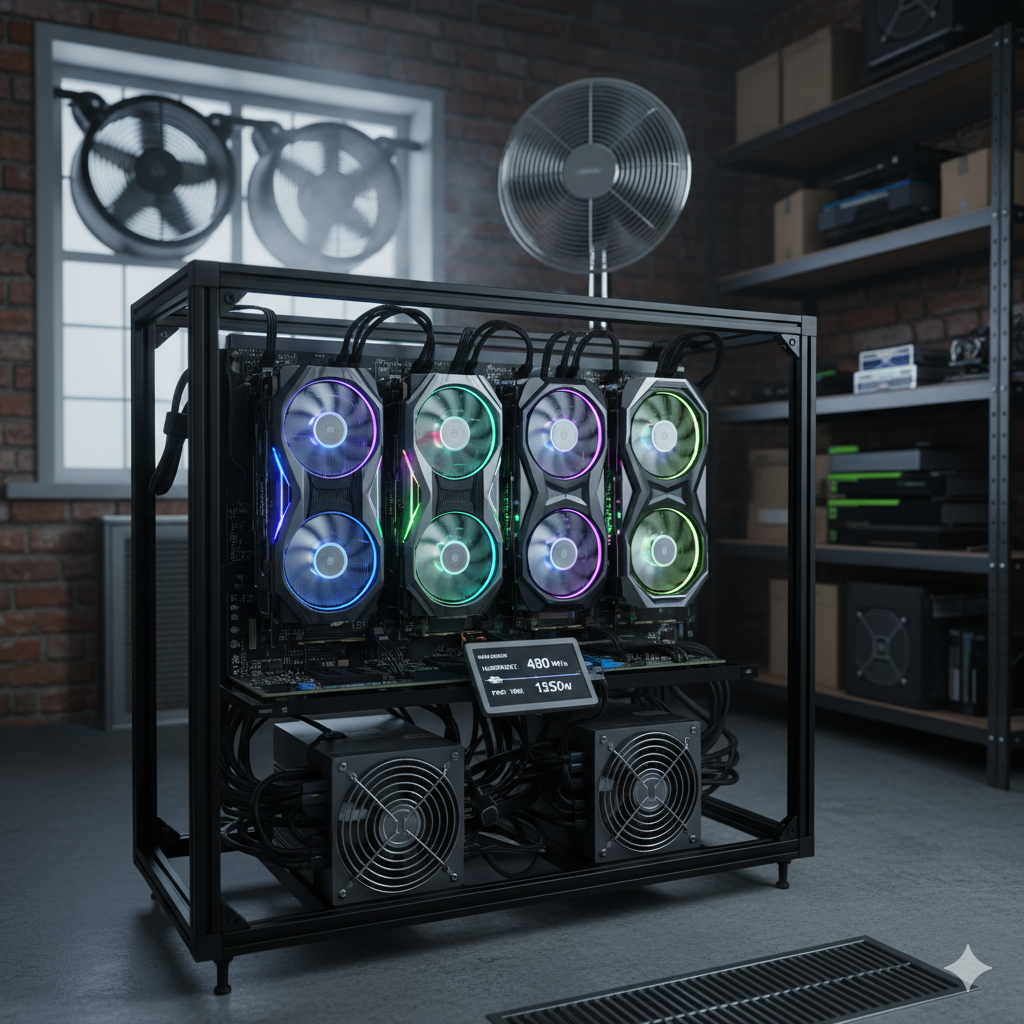欢迎,未来的数字探矿者!你是否曾好奇,像比特币和以太坊这样闪亮的加密货币是如何产生的?这不是魔法,而是“挖矿”——一个迷人的过程,它部分是技术,部分是经济学,对于去中心化的加密世界来说至关重要。如果你正打算在 2025 年涉足这个令人兴奋的领域,那么你来对地方了。这份全面、对新手友好的指南将揭开加密货币挖矿的神秘面纱,为你开始自己的数字淘金热提供坚实的基础。所以,拿起你的虚拟镐,让我们开始挖掘吧!
加密货币挖矿究竟是什么? 🤔
从本质上讲,加密货币挖矿是创建新的加密货币单位、验证交易并将其添加到区块链 (blockchain) 的过程。将区块链视为一个庞大、公开、不可更改的数字账本。每当有人向另一个人发送加密货币时,该交易都需要被记录和确认。这就是矿工发挥作用的地方!
矿工使用功能强大的计算机来解决复杂的计算难题。第一个解决难题的矿工可以将一个新的、经过验证的交易“区块”添加到区块链中,作为奖励,他将获得新铸造的加密货币和通常的交易费用。这是一场与其他矿工的竞赛,是为了那些宝贵奖励而进行的数字竞争。
这个过程具有两个关键功能:
- 创建新货币:这是新代币进入流通的方式(例如,新的比特币被“挖矿”)。
- 交易验证; 网络安全:它验证交易,防止双重支出,并保护整个去中心化网络免受欺诈和攻击。没有矿工,区块链将无法运作!
挖矿的演变:从 CPU 到 ASIC(以及更远!) 🚀
挖矿并非一直像今天这样是高科技的努力。在比特币的早期,你可以使用标准计算机的中央处理器(CPU)有效地挖矿。这简直是任何拥有个人电脑 (PC) 的人都可以做到的事情!
- CPU 挖矿(早期):速度慢、效率低,现在对于主要的加密货币来说基本上已经被淘汰了。
- GPU 挖矿(显卡的崛起):随着难度增加,矿工们意识到图形处理器(GPU – 游戏电脑中的强大芯片)效率要高得多。这导致了 GPU 挖矿的繁荣,特别是对于 altcoins(替代加密货币)而言。许多人今天仍然使用 GPU 来挖掘某些币种!
- FPGA 挖矿(短暂的插曲):Field-Programmable Gate Arrays (FPGA) 在效率方面提供了介于 GPU 和 ASIC 之间的中间地带,但它们的复杂性限制了广泛采用。
- ASIC 挖矿 (Application-Specific Integrated Circuits)(加密货币的工业革命):专用集成电路 (ASIC) 是专门设计的硬件,仅用于挖掘特定的加密货币算法(例如 Bitcoin 的 SHA-256)。这些设备极其强大且高效,但也昂贵且噪音大。ASIC 目前主导着 Bitcoin 和许多其他主要币种的挖矿操作。
- 权益证明 (Proof-of-Stake - PoS) – 一种不同的范式:至关重要的是要提到,并非所有加密货币都使用传统意义上的“挖矿”。例如,以太坊已基本从要求挖矿的 Proof-of-Work (PoW) 共识机制过渡到 Proof-of-Stake (PoS)。在 PoS 中,验证者 (validators) 不是用计算能力来解决难题,而是将他们现有的加密货币作为抵押品“质押” (stake) 以验证交易并创建新区块,从而获得奖励。这通常更节能。在本指南中,我们将重点关注 PoW 挖矿,但请记住 PoS 是加密货币领域的重要组成部分!
为什么要在 2025 年挖矿?它仍然有利可图吗? 🤔💸
这是个价值百万美元的问题!多年来,挖矿的盈利能力一直在剧烈波动。在 2025 年,它肯定不像插上一个基本电脑并看着加密货币滚滚而来那么简单了。影响盈利能力的因素包括:
- 加密货币价格:您正在挖矿的币的市场价值越高,您的奖励就越有价值。
- 挖矿难度:随着越来越多的矿工加入网络,谜题的难度增加,从而使获得奖励变得更加困难。
- 硬件成本:对 ASIC 或 GPU(图形处理器)的初始投资可能非常大。
- 电力成本:挖矿消耗大量电力。这通常是最大的持续性开支。
- 您的硬件效率:更新、更高效的硬件以更少的功耗提供相同的计算输出。
- 矿池费用 (Pool Fees): 如果您加入一个矿池(您很可能会加入),他们会从您的收入中抽取一小部分百分比。
虽然在电费高昂的地区,用单个 ASIC 进行个人业余 Bitcoin 挖矿可能难以持续盈利,但仍存在机会:
- 山寨币挖矿(Altcoin Mining)(GPU):许多较小、较新的加密货币仍在使用 PoW(工作量证明),并且可以使用 GPU(图形处理器)进行有利可图的挖矿。这些通常具有较低的难度和较少的竞争。
- 地理优势:如果您可以获得非常便宜的电力(例如,可再生能源、特定工业区),您的盈利能力会显着增加。
- 长期 HODLing(持有):一些矿工不太关注眼前的法币(fiat)利润,而更关注积累加密货币以期未来价值可能升值。
The key takeaway: Don’t go into mining blindly! Do your research and calculate potential profitability meticulously before investing.
开始:您的 2025 年挖矿清单 📋
准备好开始您的挖矿之旅了吗?以下是您需要的:
1. 选择您的加密货币和算法 🎯
首先,决定您想挖什么。这将决定您的硬件。
- Bitcoin (BTC):使用 SHA-256 算法。需要昂贵且专业的 ASIC 矿机。
- Litecoin (LTC)、Dogecoin (DOGE):使用 Scrypt 算法。可以使用 ASIC 或强大的 GPU 进行挖矿(尽管对于这些特定的币种来说,ASIC 更占主导地位)。
- Ethereum Classic (ETC) 和其他 PoW 山寨币(Altcoins):许多使用 Ethash(或其变体)等算法。主要使用 GPU(图形处理器)进行挖矿。这通常是新矿工的起点。
- Monero (XMR):使用 RandomX 算法,旨在对 CPU(中央处理器)更友好,尽管 GPU(图形处理器)也可以有效使用。
仔细研究!关注以下因素:
- 市值;价格历史:该币稳定吗?它有增长潜力吗?
- 挖矿难度;哈希率 (Hash Rate): 网络有多大的竞争力?
- 算法:它需要什么硬件?
- 社区;开发:该项目是否得到积极维护?
2. 获取合适的硬件 💻
这是您最大的前期投资。
A. 对于 ASIC 挖矿(比特币、莱特币等):
您需要一台 ASIC 矿机。这些是功能强大、专为特定目的制造的机器。
注意事项:
- Hash Rate: 矿机的原始算力(例如,每秒太哈希 – TH/s)。越高越好。
- 能效: 它每太哈希消耗多少焦耳 (J/TH) 或每 TH 消耗多少瓦特。越低越好。这直接影响您的电费。
- 价格: ASIC 的价格从几百美元到几千美元不等。
- 噪音和热量: ASIC 非常嘈杂,并产生巨大的热量。它们需要专用的通风设备和隔音空间。
B. 对于 GPU 挖矿(以太坊经典,其他 PoW 山寨币):
您将搭建一个“矿机”——本质上是一台配备多张强大显卡的专用电脑。
组件:
- 多张显卡(GPU): 您矿机的核心。目标是中等到高端的 AMD Radeon 或 NVIDIA GeForce 显卡(例如 RX 6000 系列、RTX 30 系列或更新的)。

- 主板: 必须有足够的 PCIe 插槽来容纳您的所有 GPU。
- CPU (中央处理器): 通常一个基础、便宜的 CPU (中央处理器)就足够了。
- RAM: 8 GB – 16 GB 通常就足够了。
- Storage (SSD): 一个用于您的操作系统和挖矿软件的小型 SSD (120-250GB)。
- 电源单元: 至关重要!您需要功能强大、可靠的电源单元 (PSU) 来为所有这些耗电的 GPU 供电。通常会使用多个 PSU。
- 露天矿机架: 用于安装您的所有组件,确保良好的气流,并保持设备凉爽。
- PCIe Risers: 连接 GPU 到主板的电缆,以实现更好的间距。
- Operating System: 通常是专门为挖矿设计的轻量级 Linux OS,例如 HiveOS 或 RaveOS。
3. 保护加密货币钱包 🔒
在开始挖矿之前,您需要一个安全的地方来存储您赚取的加密币。一个加密货币钱包是必不可少的。
- 软件钱包(热钱包): 您计算机或手机上的应用程序。方便,但由于连接到互联网,通常安全性较低。
- 硬件钱包(冷钱包): 存储您的私钥的物理设备(如 USB 驱动器)。安全性极高,建议用于大额加密货币。示例:Ledger、Trezor。
始终备份您的助记词 (seed phrase)(一个单词列表),并将其以极度安全的方式离线保存。这是您加密货币的关键!
4. 加入矿池 (Mining Pool) 🏊♂️
除非您拥有一个巨大的挖矿业务,否则独自挖掘主要加密货币就像试图用一张彩票中大奖。您自己解决区块的几率微乎其微。
这就是矿池 (mining pools) 发挥作用的地方。矿池是一群矿工,他们结合自己的计算能力来增加解决区块的机会。当矿池成功挖掘一个区块时,奖励会根据他们贡献的哈希算力比例分配给所有参与者。
流行的矿池 (Mining Pools)(检查您的特定币种):
- F2Pool
- ViaBTC
- AntPool
- NiceHash(略有不同,租用/购买算力)
选择矿池时的注意事项:
- 矿池费用: 通常为 1-4%。
- 支付门槛 (Payout Thresholds): 资金转入您的钱包之前您需要赚取的最低金额。
- 支付方案 (Payment Scheme): 奖励如何分配(例如,PPS、PPLNS)。
- 声誉与可靠性 (Reputation & Reliability): 选择一个信誉良好的矿池。
5. 安装挖矿软件 ⚙️
一旦您拥有了硬件并加入了一个矿池,您就需要软件来让这一切运作起来。
- 对于 ASIC: 通常带有预装的固件 (firmware)。您通常会访问一个 Web 界面来使用您的矿池详情对其进行配置。
- 对于 GPU 矿机: 您将安装一个挖矿操作系统(例如 HiveOS、RaveOS,甚至带有特定软件的 Windows),然后安装一个挖矿客户端。 流行的 GPU 挖矿客户端包括:
- T-Rex Miner
- GMiner
- LolMiner
- NBminer
这些客户端通过您选择的矿池 (pool) 地址、您的钱包 (wallet) 地址(通常作为您在矿池中的“用户名”)和密码(通常是“x”或矿工名称)进行配置。
6. 通电并监控! ⚡️📊
一旦一切设置完毕:
- 连接电源和互联网: 确保您的设置稳定。
- 启动挖矿软件: 启动挖矿过程。
- 监控您的矿机: 至关重要的是,留意:
- 温度: 运行温度过高的 GPU / ASIC 会限制性能并缩短使用寿命。确保充分冷却!
- Hash Rate: 您的实际挖矿算力。
- 功耗: 使用 kill-a-watt 功率计查看实际功耗。
- 拒绝 / 错误: 高拒绝率意味着出了问题。
- 收益: 大多数矿池提供一个仪表板 (dashboard) 来跟踪您的实时收益。
挖矿是一个持续的过程。您需要定期检查您的设备、更新软件,并可能调整设置以获得最佳性能和效率。
2025 年矿工的关键考量 🙏
- 电费: 说真的,这一点怎么强调都不为过。高昂的电价可以迅速将一项有利可图的业务变成一个烧钱的无底洞。研究您当地的费率!
- 噪音和热量: 挖矿硬件会产生大量的热量和噪音。这不是您希望放在卧室里的东西。适当的通风和专用空间至关重要。
- 互联网连接: 稳定、可靠的互联网连接至关重要。
- 维护: 灰尘堆积、风扇故障和一般磨损都很常见。请做好定期维护的准备。
- 市场波动性: 加密货币价格波动性很大。今天有利可图的东西明天可能就不是了。请保持长远的眼光。
- 法规: 加密货币法规不断发展。请随时了解您所在地区关于挖矿和加密货币收益的法律。
- 环境影响: 挖矿(尤其是 PoW)会消耗大量能源。如果可能,请考虑使用可再生能源以减少您的碳足迹。 🌍
- 诈骗: 警惕诈骗项目、云挖矿骗局和可疑的硬件销售商。做好您的尽职调查!
云挖矿是一种选择吗? ☁️
云挖矿涉及向公司付费以租用其数据中心的算力。您不拥有硬件;您只需支付费用并获得所挖加密货币的一部分。
优点:无需预先支付硬件成本,无噪音/热量/维护,潜在的用电顾虑较少。
缺点:欺诈风险高、盈利能力低(因为费用)、控制力较小,您受制于云挖矿公司的效率和诚信。
在 2025 年,虽然存在一些合法的云挖矿业务,但该领域仍然充斥着诈骗。如果考虑此选项,请务必保持高度谨慎并进行彻底研究。许多人会建议初学者不要采用它。
挖矿的未来:超越 2025 年和 PoS 🔮
尽管许多加密货币仍在进行工作量证明 (Proof-of-Work) 挖矿,但出于对能源消耗和去中心化的担忧,转向权益证明 (Proof-of-Stake) 和其他共识机制的趋势是不可否认的。 Ethereum 成功合并到 PoS 是一个里程碑式的事件。
然而,PoW 并不会完全消失。最大的加密货币 Bitcoin 仍然坚定地采用 PoW。许多其他新兴项目也选择 PoW,因为它具有公认的安全性和简单性。因此,了解 PoW 挖矿仍然是加密世界中一项宝贵的技能。
结论:您的数字淘金热正等待着! ✨
2025 年的加密货币挖矿是一项复杂但可能带来回报的努力。它需要仔细规划、大量的初始投资和持续的监控。这不是一个快速致富的计划,而是一种承诺,即在潜在地赚取数字资产的同时,为去中心化网络做出贡献。
通过了解硬件、软件、经济因素和所涉及的风险,您可以做出明智的决定,并开启您在迷人的加密挖矿世界中的旅程。祝您好运,数字探矿者 – 愿您的 哈希率 高,电费低!挖矿愉快! ⛏️💰🚀
